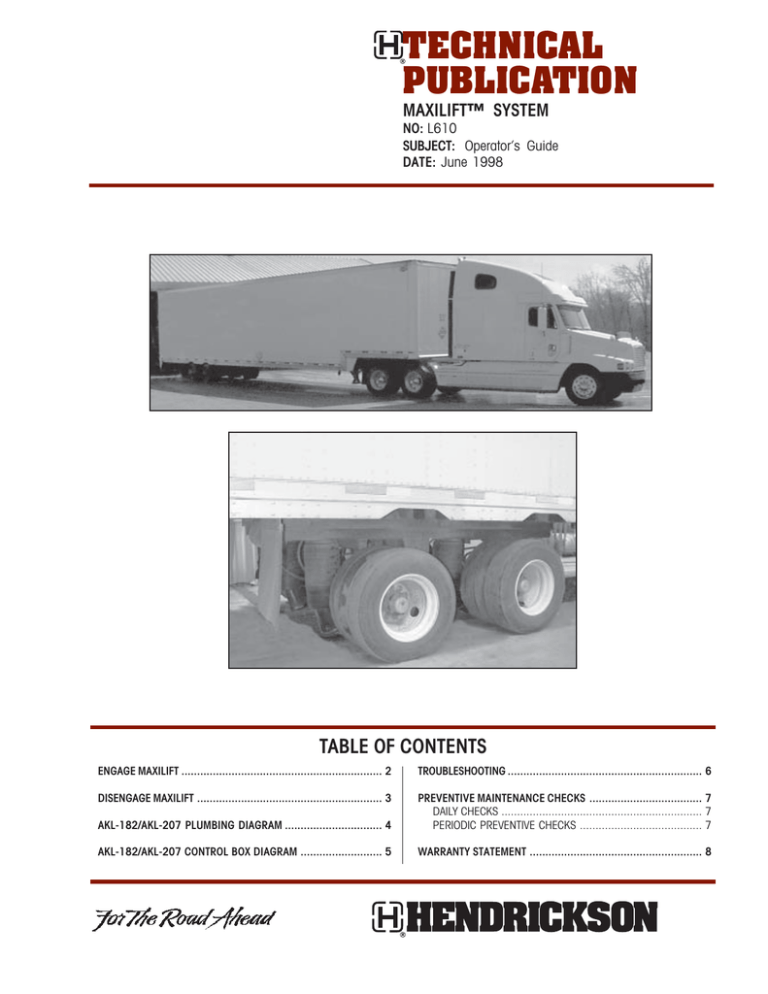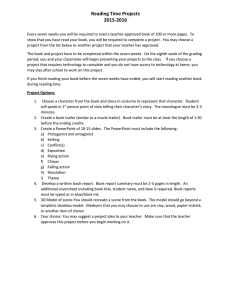
TECHNICAL
PUBLICATION
MAXILIFT™ SYSTEM
NO: L610
SUBJECT: Operator’s Guide
DATE: June 1998
TABLE OF CONTENTS
ENGAGE MAXILIFT ................................................................ 2
TROUBLESHOOTING .............................................................. 6
DISENGAGE MAXILIFT ........................................................... 3
AKL-182/AKL-207 PLUMBING DIAGRAM ............................... 4
PREVENTIVE MAINTENANCE CHECKS .................................... 7
DAILY CHECKS ................................................................ 7
PERIODIC PREVENTIVE CHECKS ....................................... 7
AKL-182/AKL-207 CONTROL BOX DIAGRAM .......................... 5
WARRANTY STATEMENT ....................................................... 8
ENGAGE MAXILIFT
ENGAGE MAXILIFT®
1. Apply the vehicle parking brakes (Figure 1).
2. Check clearance above the trailer. The top of the trailer
may hit or scrape objects above, and damage could
occur (Figure 2).
3. Release the trailer parking brakes. The trailer will not
rise with the trailer parking brakes applied (Figure 3).
IMPORTANT: It is important to maintain full-system pressure
during MAXILIFT engagement.
4. Pull out the RAISE/LOWER valve in the control box that
is located at the rear of the trailer (Figure 4).
Figure 1. Apply the parking brake
5. With the tractor running, the rear of the trailer will
begin to rise. Depending on the weight of the load and
available air-system pressure, the trailer may take as
long as 5 to 10 minutes to rise completely.
WARNING: STAY CLEAR OF THE TRAILER WHEN
MAXILIFT IS IN OPERATION. MOVEMENT OF
THE TRAILER AND/OR SUSPENSION PARTS
COULD RESULT IN SERIOUS PERSONAL
INJURY.
6. When the trailer is high enough, support stands will
automatically swing down and position themselves
over the rear axle.
IMPORTANT: The suspension will automatically dump when
the support stands are in position.
Figure 2. Check clearance above the trailer
7. Visually check to ensure that the support stands are in
position over the axle and between the u-bolts (Figure
5).
WARNING: DO NOT LOAD OR UNLOAD THE TRAILER
WITHOUT THE SUPPORT STANDS PROPERLY
POSITIONED OVER THE AXLE. IF NOT
PROPERLY POSITIONED, EXCESSIVE
TRAILER WALK AND SQUAT WILL OCCUR,
AND MAY RESULT IN SERIOUS PERSONAL
INJURY AND PROPERTY DAMAGE.
IMPORTANT: If the support stands do not lower into
position, push the RAISE/LOWER valve in and
wait until the trailer lowers, then pull the
RAISE/LOWER valve again. If the support
stands still do not position correctly, push the
RAISE/LOWER valve in and lower the trailer to
ride height. Seek assistance.
Figure 3. Release the trailer parking brake to raise the trailer
8. Check to ensure that adequate clearance exists
between the trailer and any overhead objects before
backing into a loading area (Figure 2).
CAUTION: Check for uneven surfaces before backing
with the trailer raised. The suspension
arms may hit or scrape uneven surfaces,
and damage could occur to the trailer or
the suspension (Figure 6).
RAISE/LOWER
VALVE
Figure 4. Pull out the RAISE/LOWER valve
2
ENGAGE/DISENGAGE MAXILIFT
DISENGAGE MAXILIFT
1. Before pulling the trailer away from the dock, check the
clearance above the trailer. The top of the trailer may
hit or scrape objects above it, and damage could
occur (Figure 2).
SUPPORT
STAND
2. After checking overhead clearance, pull the trailer away
from the dock before lowering the trailer to ride height.
U-BOLTS
3. Apply the tractor parking brakes. Keep the trailer
parking brakes released. The trailer will not rise with
the trailer parking brakes applied (Figure 7).
AXLE
WARNING: MAINTAIN PROPER SAFETY PROCEDURES TO
ENSURE VEHICLE STABILITY. VEHICLE
MOVEMENT DURING THIS OPERATION MAY
RESULT IN SERIOUS PERSONAL INJURY
AND PROPERTY DAMAGE.
Figure 5. Verify the support stands are over the rear axle
IMPORTANT: Apply the tractor parking brake independently
of the trailer parking brakes. Engaged trailer
parking brakes will cut the supply air needed
for the air system to operate properly.
4. With the tractor running, push in the RAISE/LOWER
valve (Figure 8).
WARNING: STAY CLEAR OF THE TRAILER WHEN
MAXILIFT IS IN OPERATION. MOVEMENT OF
THE TRAILER AND/OR SUSPENSION PARTS
COULD RESULT IN SERIOUS PERSONAL
INJURY.
Figure 6. Check clearance underneath the trailer
5. The rear of the trailer will begin to rise. Depending on
the weight of the load and available air-system
pressure, the trailer may take as long as 5 to 10
minutes to rise completely.
IMPORTANT: If the support stands do not rise off the axle,
push the RAISE/LOWER valve in and wait a
moment, then pull the RAISE/LOWER valve out
again. If the support stands still do not raise,
seek assistance.
6. The trailer will automatically lower to the designed ride
height. Visually check the trailer to ensure the
suspension is sitting at its designed ride height before
operating. Ensure the support stands are fully
retracted.
Figure 7. Release trailer parking brake to raise the trailer
CAUTION: NEVER OPERATE a trailer with support
stands engaged. Damage may occur to
the trailer or the suspension.
RAISE/LOWER
VALVE
Figure 8. Push in the RAISE/LOWER valve
3
AKL-182/AKL-207 PLUMBING
AKL-182/AKL-207 PLUMBING DIAGRAM
4
MaxiLift ® /MaxiLok® Operating Instructions
AKL-182/AKL-207 CONTROL BOX
AKL-182/AKL-207 CONTROL BOX DIAGRAM
5
TROUBLESHOOTING MAXILIFT
TROUBLESHOOTING
SYMPTOM
TRAILER WILL NOT LIFT
POSSIBLE CAUSE
CORRECTIVE ACTION
RAISE/LOWER valve not pulled out
Pull out the RAISE/LOWER valve in the
control box
Trailer parking brakes not released
Release the trailer parking brakes
Air pressure inadequate
Place air gage in the supply line to
check air system pressure
Overhead obstruction
Move trailer away from obstruction
Air line flow restriction
Check air system for obstruction or
pinched air lines and repair as
necessary
Load is too heavy
Move or transfer load
Have not waited long enough for the
trailer to rise
Wait as long as 15 minutes for the
trailer to rise
Support stands engaged
Follow disengagement procedure
found on page 3 in this publication
RAISE/LOWER valve not pushed in
Push in the RAISE/LOWER valve
Obstruction under the trailer
Remove the obstruction
Air exhaust port restricted
Make sure that there are no
restrictions in the control box, which
would not allow air to exhaust
Load is too heavy
Move or transfer load
Have not waited long enough for the
trailer to rise
Wait as long as 15 minutes for the
trailer to rise
RAISE/LOWER valve not pulled out
Pull out the RAISE/LOWER valve
Air chamber diaphragm defective on
the support stand
Replace the defective air chamber
diaphragm
Return spring on support stand
broken or weak
Replace the return spring
Load is too heavy
Move or transfer load
Air line flow restriction
Check air system for obstruction and
remove it
SUPPORT STANDS SEIZE
Support stands not lubricated
Add grease through the grease fittings
AIR SPRING LEAKS (HOLE IN BAG)
Air spring rubs on suspension beam
Check ride height and, if necessary,
adjust it
TRAILER WILL NOT LOWER
SUPPORT STANDS WILL NOT LOWER
INTO LOCKED POSITION
SUPPORT STANDS WILL NOT SWING
UP INTO STORED POSITION
6
PREVENTIVE MAINTENANCE CHECKS
PREVENTIVE MAINTENANCE CHECKS
DAILY CHECKS
1. Visually check overall condition of MAXILIFT components.
2. Visually check condition of the control box.
3. Cycle the MAXILIFT unit to verifty proper operation.
4. Listen for air leaks from the unit.
PERIODIC PREVENTIVE CHECKS
1. Complete daily checks.
2. Check condition of air lines and fittings on or to the control box.
3. Check condition of both air actuation chambers and air lines.
4. Check for missing or loose mounting bolts on MAXILIFT unit.
5. Operate the system and check for :
a. Proper control box valve operation
b. Condition of the support stands
c. Operation of the support stands
d. System operating pressure
6. Check ride height and adjust it, if necessary.
7. Check kickstand lubrication and lubricate it when needed.
7
MAXILIFT WARRANTY STATEMENT
CONDITIONS:
Hendrickson Trailer Suspension Systems warrants MAXILIFT ®, when properly installed and assembled, to be
free from defects in material and workmanship in normal use and service, subject to the limitations herein
provided. Hendrickson shall repair or replace any component that is returned to Hendrickson within the
warranty coverage period, with transportation charges prepaid by the customer and which, upon inspection
by Hendrickson, is determined to be defective in material or workmanship. Hendrickson will provide
replacement parts and material — freight prepaid — and will reimburse freight charges on returned parts
which are covered under this warranty policy. Hendrickson is not responsible for additional costs incurred
when replacement parts or materials are not acquired through Hendrickson, unless pre-approved by
Hendrickson Warranty Department.
Hendrickson Warranty Department must authorize repairs or services before they are performed. Cost and
procedures will be determined at that time. Failure to obtain such authorization may result in partial or
complete loss of warranty coverage.
COVERAGE PROVISIONS:
36 months or 300,000 miles*
Mechanical Components:
(Up to 12 months or 100,000 miles)*
(12 to 36 months or 100,000 to 300,000 miles)*
Parts and labor
Parts only
Air System Components:
(Up to 12 months or 100,000 miles)*
Parts and labor
Suspension Components:
See L583 Comprehensive Warranty Statement
for coverage
*Whichever comes first.
THE FOREGOING IS HENDRICKSON’S ONLY WARRANTY, AND ALL OTHER WARRANTIES, WHETHER EXPRESSED
OR IMPLIED, INCLUDING, BUT NOT LIMITED TO, THE IMPLIED WARRANTIES OF MERCHANTABILITY OR
FITNESS FOR A PARTICULAR PURPOSE, ARE HEREBY DISCLAIMED.
This warranty does not apply to failures resulting from improper installation, neglect, absence of periodic
maintenance, accident, misuse, operation beyond the rated capability of the model or the vehicle to which it
is attached, nor to any parts which have been altered or repaired without the written consent of Hendrickson.
In no event shall Hendrickson be liable for indirect, special, incidental, or consequential damage of any
nature.
Hendrickson assumes no responsibility for wear, damage or deterioration of parts, or changes in adjustments
as a result of normal service. Examples include, but are not limited to, the following items: air chamber
diaphragm, and return spring.
Information in this literature was accurate at the
time of publication. Product changes may have
been made after the copyright date that are not
reflected.
L610 June 1998 Printed in United States of America
2070 Industrial Place SE • Canton, Ohio 44707-2600 USA
Phone: (330) 456-7288 • Fax: (330) 456-0105
250 Chrysler Drive, Unit #3 • Brampton, Ontario L6S 6B6 CAN
Phone: (905) 789-1030 • Fax: (905) 789-1033
The Boler Company. Copyright © 1998
Hendrickson Trailer Suspension Systems
All Rights Reserved

